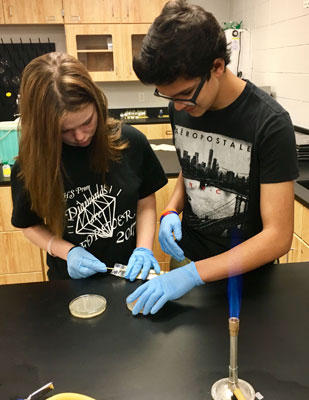August 29, 2017 • Headline News
Pick up a copy of the newspaper your local newsstand.

PAGE UPDATED BY MARIA SIEVERDING AUGUST 29, 2017 10:30 A.M.
South Ripley offers 4 years of BioMedical courses
Jared Rogers
STAFF WRITER
“Former students come home on college break and tell me they are the best prepared student in their lab-based class; and that their professors are surprised at their skill set.” South Ripley High School teacher Max Howard is referring to the classes he teaches within the school’s BioMed program, a series of lab-based medical science courses that has grown in recent years. In fact, this 2017-18 school year marks the first year that South Ripley offers a “full” curriculum in the program, meaning they have implemented four tiers of courses for students to take, beginning as freshmen and continuing through graduation.
 SUBMITTED PHOTO
SUBMITTED PHOTO
BioMed students Jayden Hunger and Mark Powers work on a lab involving petri dishes.
The program resides under the Project Lead the Way initiative, a nationwide effort to increase STEM proficiency and interest in high school students. STEM, an acronym for science, technology, engineering, and math, is a buzzword topic in education today, as U.S. schools seek to remain innovative and competitive in a global society. BioMed is just one aspect of STEM programming offered at Ripley County schools, but it is indeed an exciting opportunity.
South Ripley is one of few schools in the southeast Indiana region offering the full BioMed curriculum, and administrators and staff are proud of the program’s success thus far. “It is phenomenal for kids to get a head start in the medical field,” Howard says, adding, “It’s the best lab, hands-on, and inquiry based curriculum I’ve seen.” He says the courses offer both content knowledge fused with the development of real-world skills. For example, students in the level two, “human body systems” course, learn anatomy, physiology, and kinesiology principles; while learning medical techniques for measuring heart rhythms, heart rate, and blood pressure.
The tiers of the program are as listed: level one - principles of biomedical sciences; level two - human body systems; level three - medical interventions (learning to treat diseases, for example); and level four - biomedical innovations.
In the new level four course, objectives are threefold. One aspect is professional shadowing, where students learn directly from a medical professional practicing locally. Second, students work to invent new, or improve upon existing, medical devices. Third, students research genetics. At the end of the course, students present their medical inventions and genetic research to an assembled panel of local medical professionals.
Building up the BioMed program has been a team effort, within South Ripley and also beyond. High school principal Rod Hite, who previously served as junior high principal and helped get the BioMed program started, shares that connections are currently being built with local hospitals for shadowing opportunities. The school already works closely with Genesis: Pathways to Success, the Ripley County level STEM initiative; and with Eastern Indiana Area Health Education Center (EI-AHEC). “We seek to create these connections so that the schools are the hub of our community,” Principal Hite says.
EI-AHEC, partnering with Margaret Mary Health, offers a Summer Medical Scholars camp, open to only 12 students in the area’s participating 14 counties. South Ripley has been represented by seven students last year, and five this year, thanks to the BioMed curriculum and the growing potential it provides to students who participate. In addition to summer learning experiences, students completing the program may earn up to nine credit hours at IUPUI.
The BioMedical program is open to participation by Jac-Cen-Del and Milan students, and although only one student from JCD has been able to take a course, the hope is to increase these collaborations, too. “Thanks to the building renovations in 2009-10, we have state of the art lab facilities,” Hite says. Howard echoes, “It’s the best lab space we could ask for, and we want to draw more students in.”
Ten students currently seek to complete their fourth year in the program. Eleven are in their third year; 23 in the second; and 28 take the introductory level course. Teacher Max Howard returns to his ninth school year at SR with a fresh energy to guide those students. He was awarded a teacher creativity grant through Eli Lilly this summer, and used it to study biology and ecology in New Zealand’s rainforests. He has also completed specific professional development to teach the BioMed courses. Of course, he enjoys these occasions, but he smiles as he looks to the school year ahead: “I’m ready to be back to teaching in the classroom.”
Learning the lingo of Social Security
Charo Boyd
SOCIAL SECURITY ADMINISTRATION
 Is Social Security a topic in your conversations these days? Are you familiar with the lingo used to describe Social Security benefits, or does it sound like a new vocabulary to you?
Is Social Security a topic in your conversations these days? Are you familiar with the lingo used to describe Social Security benefits, or does it sound like a new vocabulary to you?
Social Security employees strive to explain benefits using easy-to-understand, plain language. But if a technical term or acronym (an abbreviation of the first letters of words in a phrase) that you don’t know slips into the conversation or appears in written material, you can easily find the meaning in our online glossary at www.socialsecurity.gov/agency/glossary.
Social Security acronyms function as verbal shorthand in our financial planning conversations. If you’re nearing retirement, you may want to know what PIA (primary insurance amount), FRA (full retirement age), and DRCs (delayed retirement credits) mean. These terms involve your benefit amount based on when you decide to take it. If you take your retirement benefit at FRA, you’ll receive the full PIA (amount payable for a retired worker who starts benefits at full retirement age). So, FRA is an age and PIA is an amount. What about DRCs? Delayed retirement credits are the incremental increases added to the PIA if you delay taking retirement benefits beyond your full retirement age. If you wait to begin benefits beyond FRA — say, at age 68 or even 70 — your benefit increases.
Once you receive benefits, you get a COLA most years. But don’t expect a refreshing drink — a COLA is a Cost of Living Adjustment, and that will usually mean a little extra money in your monthly payment.
Knowing some of these terms can help you fine-tune your conversations about Social Security. If one of those unknown terms or acronyms does come up in conversation, you can be the one to supply the definition using our online glossary. Sometimes learning the lingo can deepen your understanding of how Social Security works for you. Discover more at www.socialsecurity.gov.
PAGE UPDATED BY MARIA SIEVERDING AUGUST 29, 2017 10:30 A.M.
South Ripley offers 4 years of BioMedical courses
Jared Rogers
STAFF WRITER
“Former students come home on college break and tell me they are the best prepared student in their lab-based class; and that their professors are surprised at their skill set.” South Ripley High School teacher Max Howard is referring to the classes he teaches within the school’s BioMed program, a series of lab-based medical science courses that has grown in recent years. In fact, this 2017-18 school year marks the first year that South Ripley offers a “full” curriculum in the program, meaning they have implemented four tiers of courses for students to take, beginning as freshmen and continuing through graduation.
 SUBMITTED PHOTO
SUBMITTED PHOTOBioMed students Jayden Hunger and Mark Powers work on a lab involving petri dishes.
The program resides under the Project Lead the Way initiative, a nationwide effort to increase STEM proficiency and interest in high school students. STEM, an acronym for science, technology, engineering, and math, is a buzzword topic in education today, as U.S. schools seek to remain innovative and competitive in a global society. BioMed is just one aspect of STEM programming offered at Ripley County schools, but it is indeed an exciting opportunity.
South Ripley is one of few schools in the southeast Indiana region offering the full BioMed curriculum, and administrators and staff are proud of the program’s success thus far. “It is phenomenal for kids to get a head start in the medical field,” Howard says, adding, “It’s the best lab, hands-on, and inquiry based curriculum I’ve seen.” He says the courses offer both content knowledge fused with the development of real-world skills. For example, students in the level two, “human body systems” course, learn anatomy, physiology, and kinesiology principles; while learning medical techniques for measuring heart rhythms, heart rate, and blood pressure.
The tiers of the program are as listed: level one - principles of biomedical sciences; level two - human body systems; level three - medical interventions (learning to treat diseases, for example); and level four - biomedical innovations.
In the new level four course, objectives are threefold. One aspect is professional shadowing, where students learn directly from a medical professional practicing locally. Second, students work to invent new, or improve upon existing, medical devices. Third, students research genetics. At the end of the course, students present their medical inventions and genetic research to an assembled panel of local medical professionals.
Building up the BioMed program has been a team effort, within South Ripley and also beyond. High school principal Rod Hite, who previously served as junior high principal and helped get the BioMed program started, shares that connections are currently being built with local hospitals for shadowing opportunities. The school already works closely with Genesis: Pathways to Success, the Ripley County level STEM initiative; and with Eastern Indiana Area Health Education Center (EI-AHEC). “We seek to create these connections so that the schools are the hub of our community,” Principal Hite says.
EI-AHEC, partnering with Margaret Mary Health, offers a Summer Medical Scholars camp, open to only 12 students in the area’s participating 14 counties. South Ripley has been represented by seven students last year, and five this year, thanks to the BioMed curriculum and the growing potential it provides to students who participate. In addition to summer learning experiences, students completing the program may earn up to nine credit hours at IUPUI.
The BioMedical program is open to participation by Jac-Cen-Del and Milan students, and although only one student from JCD has been able to take a course, the hope is to increase these collaborations, too. “Thanks to the building renovations in 2009-10, we have state of the art lab facilities,” Hite says. Howard echoes, “It’s the best lab space we could ask for, and we want to draw more students in.”
Ten students currently seek to complete their fourth year in the program. Eleven are in their third year; 23 in the second; and 28 take the introductory level course. Teacher Max Howard returns to his ninth school year at SR with a fresh energy to guide those students. He was awarded a teacher creativity grant through Eli Lilly this summer, and used it to study biology and ecology in New Zealand’s rainforests. He has also completed specific professional development to teach the BioMed courses. Of course, he enjoys these occasions, but he smiles as he looks to the school year ahead: “I’m ready to be back to teaching in the classroom.”
Learning the lingo of Social Security
Charo Boyd
SOCIAL SECURITY ADMINISTRATION
 Is Social Security a topic in your conversations these days? Are you familiar with the lingo used to describe Social Security benefits, or does it sound like a new vocabulary to you?
Is Social Security a topic in your conversations these days? Are you familiar with the lingo used to describe Social Security benefits, or does it sound like a new vocabulary to you? Social Security employees strive to explain benefits using easy-to-understand, plain language. But if a technical term or acronym (an abbreviation of the first letters of words in a phrase) that you don’t know slips into the conversation or appears in written material, you can easily find the meaning in our online glossary at www.socialsecurity.gov/agency/glossary.
Social Security acronyms function as verbal shorthand in our financial planning conversations. If you’re nearing retirement, you may want to know what PIA (primary insurance amount), FRA (full retirement age), and DRCs (delayed retirement credits) mean. These terms involve your benefit amount based on when you decide to take it. If you take your retirement benefit at FRA, you’ll receive the full PIA (amount payable for a retired worker who starts benefits at full retirement age). So, FRA is an age and PIA is an amount. What about DRCs? Delayed retirement credits are the incremental increases added to the PIA if you delay taking retirement benefits beyond your full retirement age. If you wait to begin benefits beyond FRA — say, at age 68 or even 70 — your benefit increases.
Once you receive benefits, you get a COLA most years. But don’t expect a refreshing drink — a COLA is a Cost of Living Adjustment, and that will usually mean a little extra money in your monthly payment.
Knowing some of these terms can help you fine-tune your conversations about Social Security. If one of those unknown terms or acronyms does come up in conversation, you can be the one to supply the definition using our online glossary. Sometimes learning the lingo can deepen your understanding of how Social Security works for you. Discover more at www.socialsecurity.gov.














